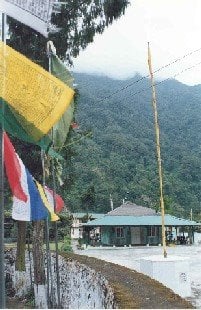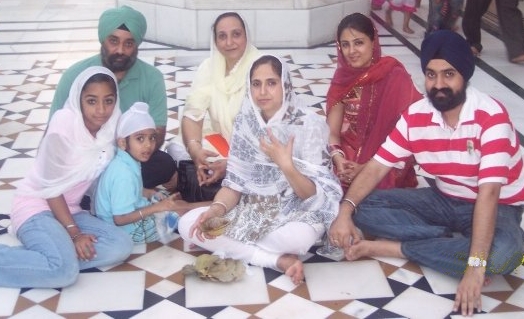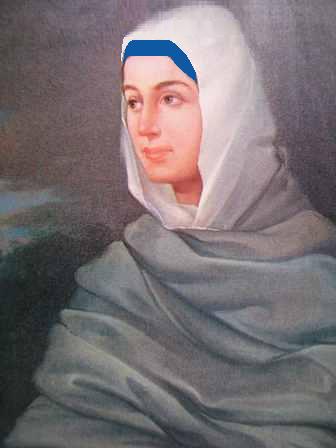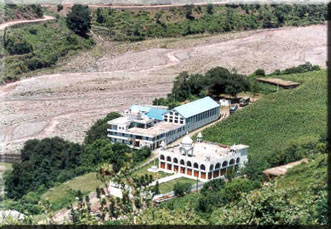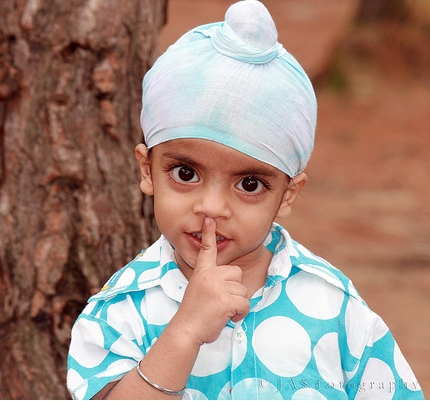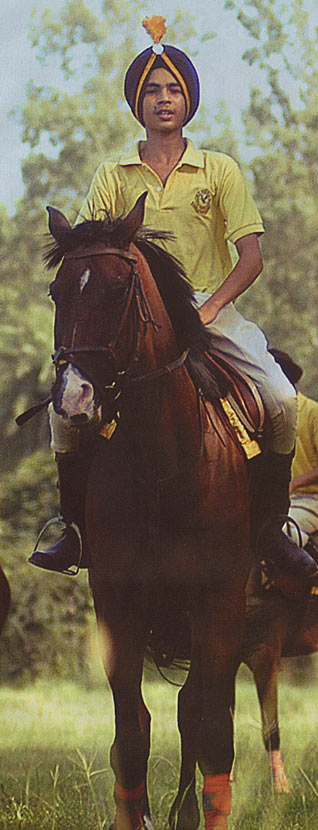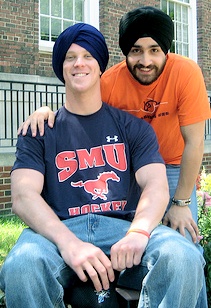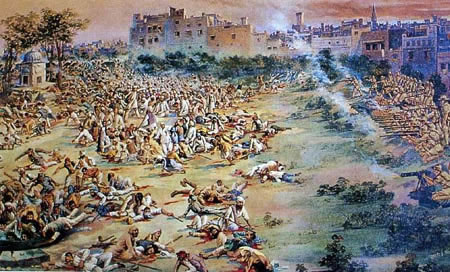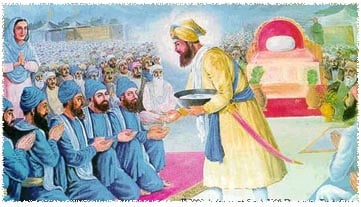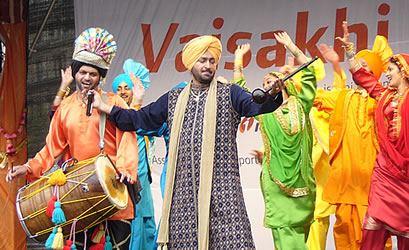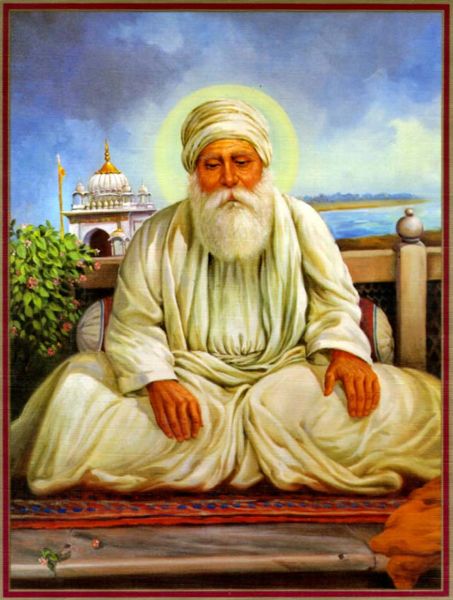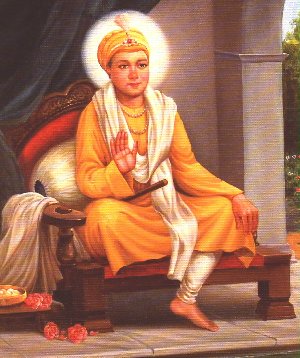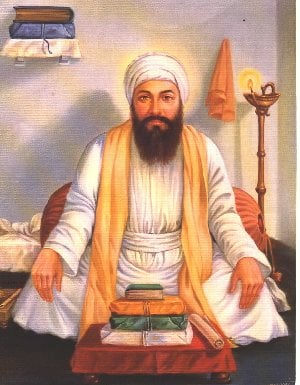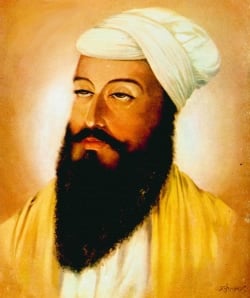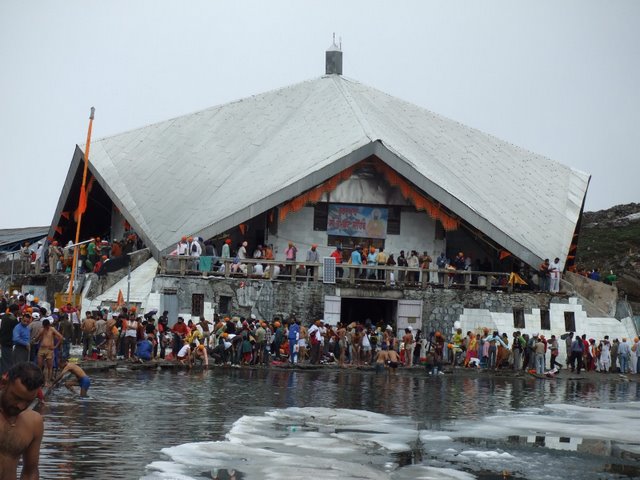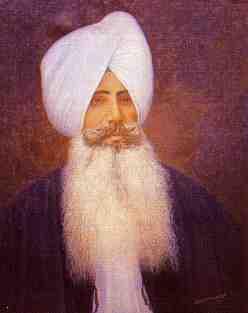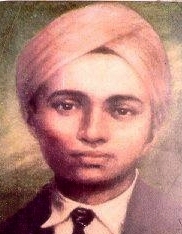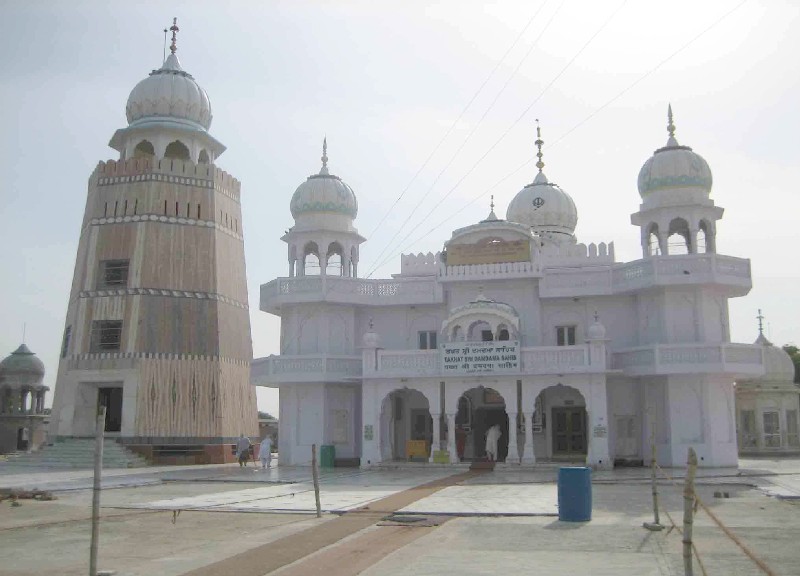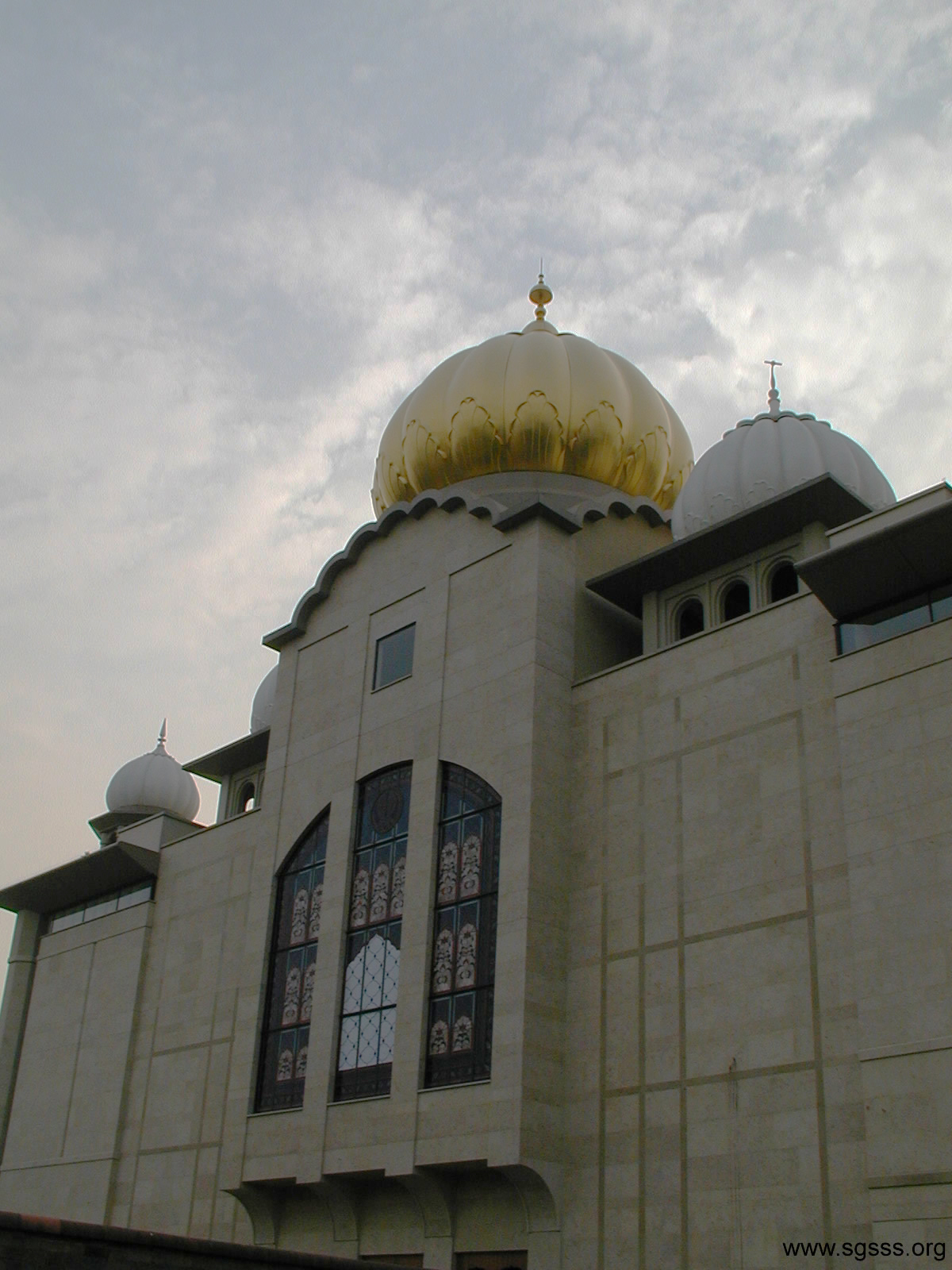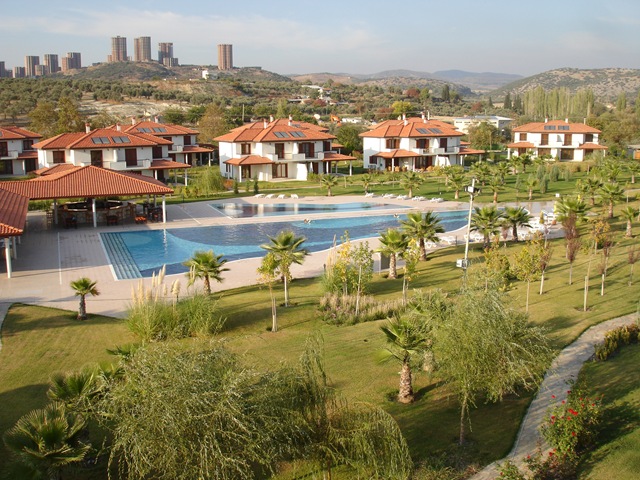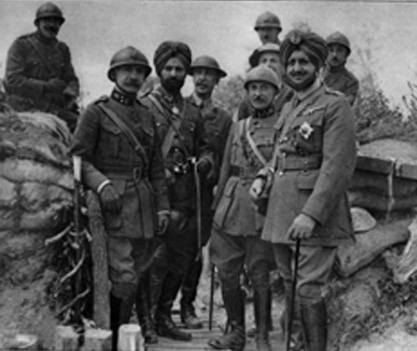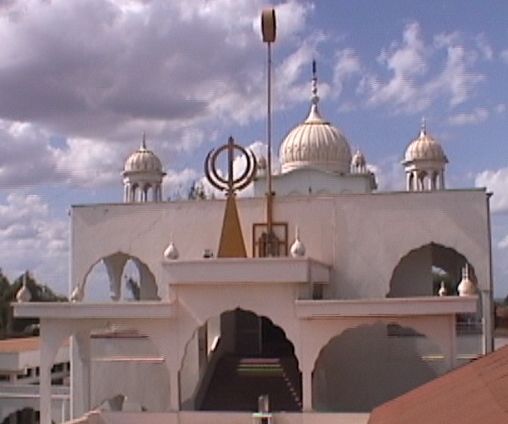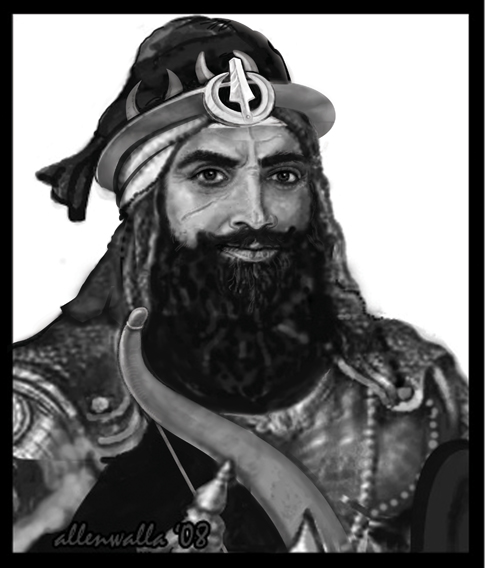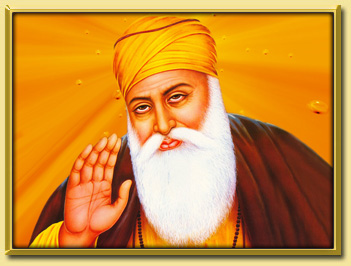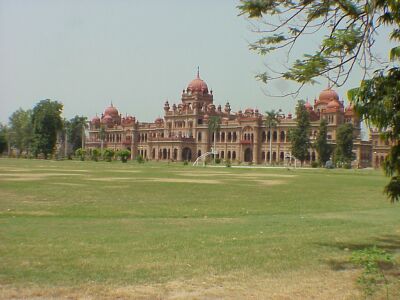SikhiWiki:Today's featured article/April 2009
Today's featured article archive
2007 -
2008 -
2009 -
2010 -
January - February - March - April - May - June - July - August - September - October - November - December
Today is Tuesday, November 4, 2025; it is now 11:55 UTC
Featured content:
| << | Today's featured articles for April 2009 | >> | ||||
| Su | Mo | Tu | We | Th | Fr | Sa |
| 1 | 2 | 3 | 4 | |||
| 5 | 6 | 7 | 8 | 9 | 10 | 11 |
| 12 | 13 | 14 | 15 | 16 | 17 | 18 |
| 19 | 20 | 21 | 22 | 23 | 24 | 25 |
| 26 | 27 | 28 | 29 | 30 | ||
- April 1
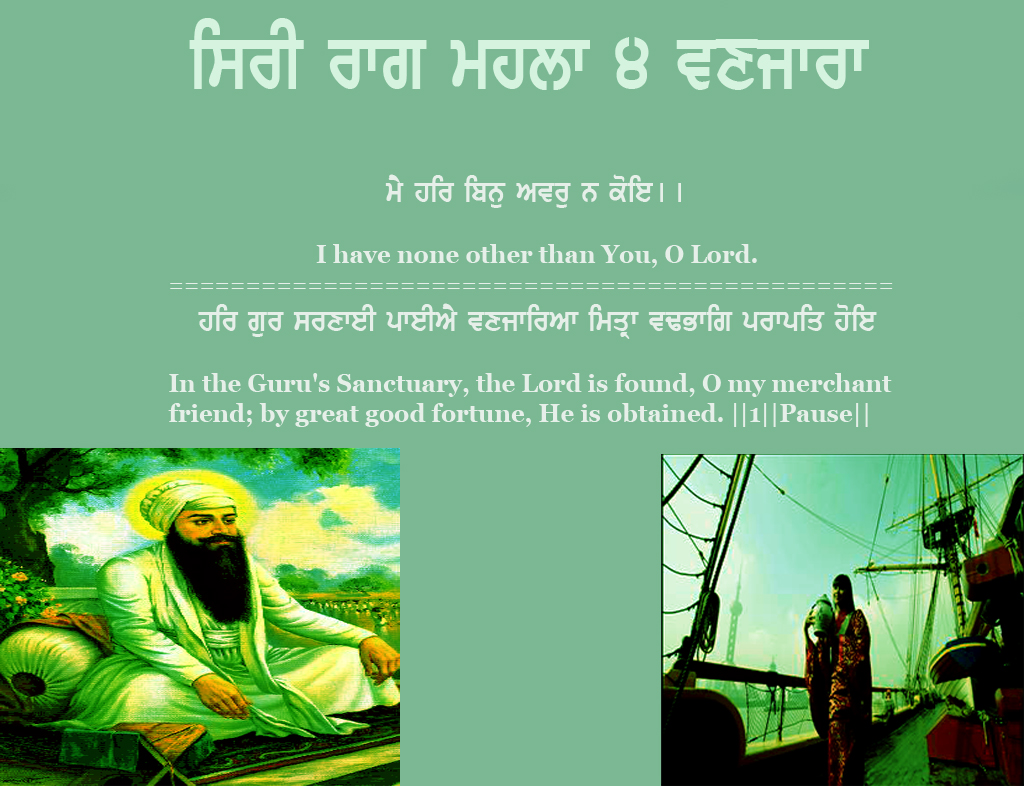
Vanjara is poetry in the form of Gurbani in the Guru Granth Sahib. It was composed by Guru Ram Das in Sri Raag.
In this poetry, the Guru is giving advise and pointing the "Vanjara" (the merchant or trader), in the correct spiritual direction. He is calling him a friend and telling him how to find the Lord.
The Guru says that the trader or merchant who remembers God's name will always be blessed just like Baba Makhan Shah Labana, who was a trader who was blessed by Guru Tegh Bahadur as he performed Ardas before the Guru to help save his doomed ship.
The trader who remembers the Lord at all times, the Guru says moves away from ego. The ones who remain attached to Maya and are egoistic are called "prostitute's son" as they do not recognise God as their father. Ego comes from wealth and it is common that traders are money minded and attached to their wealth.
So the Guru gives traders clear advise not to be attached emotionally to Maya or money because money will never go with you in the end - those attached to money will "depart crying". When you are young and in good health, recite the Lord's Naam because soon the youth and good health will leave and you will have no support. .....More
view – talk – edit – history
- April 2
This wonderful historical Gurudwara is situated in Chungthang, which is a town in North Sikkim, an Indian state. Sikkim is a small but beautiful landlocked state nestled in the Himalayas in northern India. It is situated at the confluence of two rivers: River Lachen and Lachung Chu, both tributaries of the "most scenic" River Teesta. The thumb-shaped state borders Nepal in the west, the Chinese Tibet Autonomous Region to the north and east, Bhutan in the south-east and the Indian state of West Bengal to its south.
Chungthang is located in this state at a distance of 95 kilometres from the capital Gangtok, at an elevation of 1,700 metres (5,600 ft). Guru Dongmar is a lake at a height of 18,000 feet alongside a glacial peak known by the same name. The lake remains frozen most of the year due to heavy snowfall for almost six months each year. .....More
view – talk – edit – history
- April 3
In India before the advent of Guru Nanak, the life of the ascetic or recluse was regarded as the best way to connect to God.
However, Guru Nanak changed that by saying that the life of the householder - the "spiritual path of the householder" or "Grist Marg" was the preferred route to attain the highest level of spirituality in this era of Kaljug.
Guru Nanak taught that the ideal householder's life is spent in selflessly carrying out one's duties to family and society while at all times remembering God and serving His saints; engaged in gainful labour one is to nurture ones family; take care of the local community and protect the weak.
Sikhism is a monotheistic faith, which teaches that there is only one God; that is not subject to time or space; that is the Creator, Sustainer and Destroyer of the Universe and everything in it.
Moreover in Sikhism, ethics vales and religion go hand in hand. The inculcation of moral qualities and the practice of virtue in everyday life is a vital step towards spiritual development. .....More
view – talk – edit – history
- April 4
Mata Sunder Kaur (Mata Sundri) was the wife of Guru Gobind Singh (1666-1708). She was the daughter of Bhai Ram Saran, a Kumarav Khatri of Bajwara, in present-day Hoshiarpur district of the Punjab.
She was married to the tenth Sikh Guru at Anandpur on 4 April 1684. The father-in-law had desired that the bridegroom should come at the head of a marriage party to Lahore where the ceremony should be performed with due dignity.
The fateful events leading to the martyrdom of Guru Tegh Bahadur intervened, and in the changed circumstances it was not possible for the young Guru to go to Lahore. Therefore a temporary encampment was raised near the village of Basantgarh, 10 km north of Anandpur, and named Guru ka Lahore where the nuptials were held on 23 Har 1734 Bk/21 June 1684. Mata Jito ji became Mata Sundari ji after marriage as was the custom in Punjabi families.
Four sons were born to Mata Jito/Sundar - Baba Ajit Singh (b:11 February 1687), Baba Jujhar Singh (9 April 1691), Baba Zorawar Singh (28 November 1696) and Baba Fateh Singh (12 December 1699). Mata ji received Amrit at the 1699 Vaisakhi Amrit Sanchaar ceremony and adopted the name 'Sunder Kaur'. Mata Sundari raised her four sons on the martyrdom tales of their grandfather Guru Tegh Bahadur and great great grandfather Guru Arjan Dev. .....More
view – talk – edit – history
- April 5
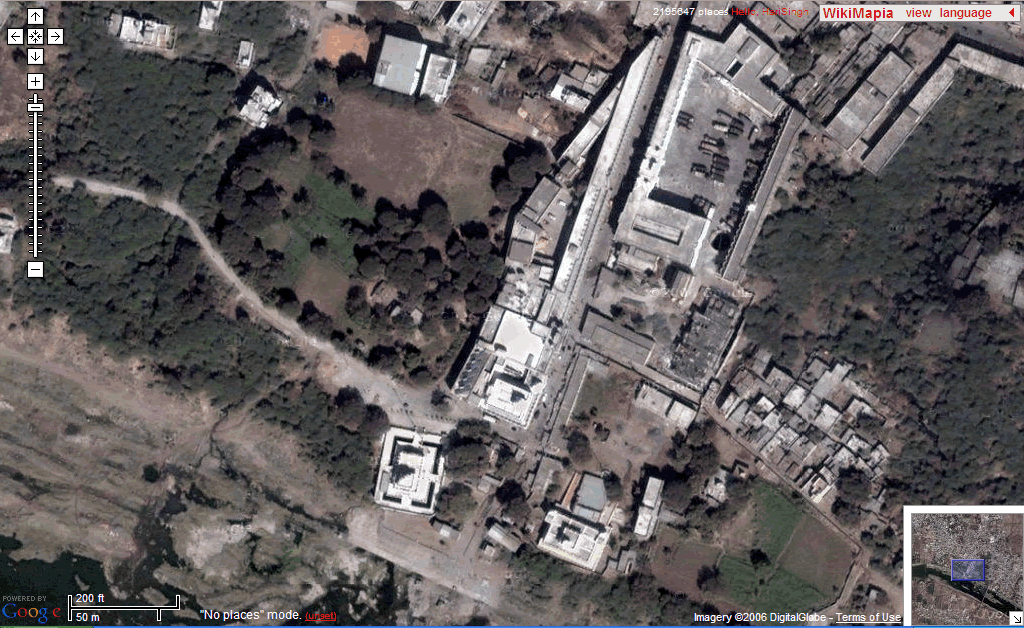
Takhat Sachkhand Sri Hazoor Sahib is the principal Sikh shrine at Nanded in the Indian state of Maharashtra. It marks the site where Guru Gobind Singh had his camp in 1708 after the departure of the emperor Bahadur Shah and where in October 2008, the 300th anniversary celebration of the Guruship of Guru Granth Sahib took place.
The tenth Guru held his court and congregation here. It is the site of his own tent where he was convalescing after he was attacked by assassins and the place at which Guru Gobind Singh ji 's light rose to rejoin the light of the Creator.
This site is now one of the five Takhats which are places of primary historical importance to the Sikhs. The other four takhats are: Akal Takhat at Amritsar, Takhat Keshgarh Sahib at Anandpur, Takhat Patna Sahib in Bihar District and Takhat Damdama Sahib in Talwandi Sabo, Bhatinda, Punjab.
In 1708 being prescient of the end of his earthly role, the Guru had dispatched five of his Sikhs under the command of his newly appointed Jathedar Banda Singh to Punjab and Mata Sahib Devan under a separate escort to Delhi before the stabbing incident. He told the rest of his retinue to retire to their homes if they so wished, but he bade one Bhai Santokh Singh to stay on here and keep Guru ka Langar going. .....More
view – talk – edit – history
- April 6

Anand Karaj (Punjabi: ਅਨੰਦ ਕਾਰਜ, anand kāraj) is the name given to the Sikh wedding ceremony, literally translated as "Blissful Event".
Sikhs regard marriage as a sacred bond of mutual dependence between a man and a woman; a true partnership of equals in marriage is made between those who are united in spirit as well as in mind and body.
Marriage is regarded as a strong lifetime bond between the bride and groom and and a union between both the families of the bride and groom.
Based on the concept depicted in Laava, the Sikh marriage is not merely a physical and legal contract but is intended to be a fusion of the souls; a holy union between two souls, where physically they appear as two individual bodies but in fact are united as one both spiritually and in thinking. The couple must feel and think alike and both must identify with the other, i.e. they need to become "Ek Jot Doe Murti" meaning "one spirit in two bodies".
The Laava, or four stanzas, are read and then sung during the ceremony to formalize and sanctify the marriage. .....More
view – talk – edit – history
- April 7
The Sikh religion has various established beliefs and values that are inherent in the basic philosophy of the faith. A Sikh's primary belief is in only one supreme God – This sole God is the same for all the peoples of the Universe.
Guru Arjan, the fifth Sikh Guru highlights this point by saying in the Sikh holy text called the Guru Granth Sahib, "There is only the One Supreme Lord God; there is no other at all" (SGGS p 45); this belief is the starting point of the Sikh faith.
Next, God is considered gender neutral in Sikhism. So when a Sikh refers to "God", this God can be referred to as masculine or feminine; so God can be called ‘He’ or ‘She’. Guru Arjan reinforces this concept by saying: "You are my Father and You are my Mother.....You are my Protector everywhere...." (SGGS p 103).
Further, this one God is the same God of the Sikhs, Hindus, Muslims, Christians, Jews, etc – of all the peoples of the world; everyone in this world belongs to that same one God! Guru Ram Das, the fourth Sikh Guru explains: "All living beings are Yours - You are the Giver of all souls" (SGGS p 10). .....More
view – talk – edit – history
- April 8
Gurudwara Nangali Sahib is situated in the lap of a picturesque hill and on the bank of Drungali Nallah. It is about 4 kms from Poonch town in Poonch district, which is the smallest of the 14 districts of Jammu & Kashmir state. It is one of the oldest shrine of the Sikhs in Northern India.
Presently the Gurudwara complex consists of the main Gurdwara building, a Langar Hall and about 70 living rooms. Large number of devotees belonging to all faiths visit this shrine from all over the country every year.
This holy Sikh shrine is approximately 240 Kms from Jammu city by road (but only about 150km as the crow flies)which in turn is connected to rest of the world via road, rail and airline network. Pilgrims outside the state may use railways or air services up to Jammu and then travel by road to Poonch.
The Gurdwara was established by Thakur Bhai Mela Singh ji (Fourth successor of Sant Bhai Feru Singh ji) in 1803 AD. Maharaja Ranjit Singh visited Gurdwara Nangali Sahib in 1814 and was very much impressed by it. .....More
view – talk – edit – history
- April 9
The Sikh Guru tells us very clearly that speaking lies is wrong and will lead the person away from God; he or she will not find peace or solace and the result will only be continuous misery and sadness.
The motivation of telling lies is greed; the person speaking lies has some gain at the back of their mind; it may just be done for a laugh but whatever the motivation, the Guru says that greed is the spark that leads one to lie.
The Guru says, "What can anyone do, with greed within? O Siblings of Destiny, by telling lies, they eat poison.(4)" (SGGS p 635) The greed within results in the person succumbing to the temptation to lie and satisfy this inner need.
The Guru compares the telling of lies to the "...eating of poison". This is repeated many times. On page 948 of the holy Granth, the Guru tells us "Speaking lies, one eats poison; the self-willed manmukh departs, crying out in pain" (SGGS p 948). Again "speaking lies one eats poison" is repeated. .....More
view – talk – edit – history
- April 10
The Knight Riders
They come galloping on horse-back with lances in their hands, pick up a wooden peg and pass off in a whiff, leaving you marvelling at the sort of stuff these young guns are made of.
The scene is no take from a cavalry strike - they are the riders, regal and fearless, of sadda Punjab, where equestrian sport has just arrived in a big way, moving away from the confines of police and military equestrian academies. Be it the swanky Chandigarh Horse Riding Society next to the picturesque Sukhna Lake or the Punjab Public School Riding Academy in the princely town of Nabha, young boys and girls are taking to this royal sport passionately, like never before.
Not to be left behind are equestrian academies of Kirpal Sagar Academy in Punjab's hinterland (Nawanshahr) and the Shivalik Riding and Pony Club at Chandimandir, headquarters of the western command.
Each of the academies are providing riding opportunities to explore the centuries old bond between man and horse which kept improving considerably as the role of the horse kept changing. ...Continued
view – talk – edit – history
- April 11
Dasam Granth contains 1428 pages and is the collection of the writings by the 10th "Patshah", Sri Guru Gobind Singh ji. It starts with his Jaap Sahib, the Akal Ustat or praise of the Creator and the Bachitar Natak or "Wonderful Drama", which gives an account of the Guru's parentage, his divine mission, the battles fought, etc.
Then come three abridged translations of the Devi Mahatamya, an episode in the Markandeya Puran, in praise of Durga the Goddess of war (Chandi Chritras: Chandi Chritra I, Chandi Chritra II, Chandi Ki Var).
Then follows the Gyan Parbodh, or awakening of knowledge; Chobis Avatar - accounts of twenty-four incarnations of the Vishnu, according to the Hindus, and Brahmavatar and Rudravtar, selected because of their warlike character; the Shabad Hazare; quatrains called Sawaiyas, which are religious hymns in praise of God and reprobation of idolatry and hypocrisy; the Khalsa Mahima, or words in praise of the Khalsa.
The final section contains, Shastar Nam Mala, a list of offensive and defensive weapons used in the Guru's time, with special reference to the attributes of the Creator; the Charitropakhyan, or tales illustrating the qualities of people, but principally the deceit and tricks of women; the Kabiovach Bainti Chaupai will "absolve the suffering, pain or fear of the person, who will even once recite this Bani"; the Zafarnama, containing the tenth Guru's epistle to the Emperor Aurangzeb; and Hikayats, several metrical tales in the Persian language. .....More
view – talk – edit – history
- April 12
International Turban Day is celebrated on April 13th every year. This event was started in 2004 to bring awareness of the strict requirement on Sikhs to don the turban as a mandatory part of their religion.
In the West since 9/11 in 2001, the turban, has attracted negative attention due to the wrongful linking of this garment with Osama bin Laden, the Muslim leader of al Qaeda who has often been pictured wearing a turban.
Due to the vast news and media coverage of Osama bin Laden following 9/11, many men wearing a turban and beard and Punjabi styled clothing articles (long vest or longer shirt) have been looked upon with suspicion, with some innocent people even being killed or wounded by uninformed and even deranged westerners bent on revenge, who just assumed that any bearded man, wearing a turban and beard was a Muslim.
However, this perception is wrong, as the vast majority of people in Western countries who wear turbans are actually Sikhs. Given that many thousands of Sikhs died fighting against the same sort of Muslim fundamentalist terrorists that bin Laden's group al Qaeda and the Taleban espouse today, the irony of such an uninformed assumption is tragic, especially since most Muslims living in the West do not wear turbans. .....More
view – talk – edit – history
- April 13
Jallianwala Bagh Massacre, involved the killing of hundreds of unarmed, defenceless Indians by a senior British military officer. The incident took place on 13 April 1919 in the heart of Amritsar, the holiest city of the Sikhs, on a day sacred to them called Vaisakhi - the birth anniversary of the Khalsa.
Jallianvala Bagh, a garden belonging to the Jalla, derives its name from the owners of this piece of land in olden times. At the time of this incident, this land belonged to the family of Sardar Himmat Singh Jallevalia (d.1829), a noble in the court of Maharaja Ranjit Singh (1780-1839), who originally came from the village of Jalla, now in Fatehgarh Sahib district of the Punjab.
The family were collectively known as Jallhevale or simply Jallhe or Jalle, although their principal seat later became Alavarpur in Jallandhar district. The site, once a garden or garden house, was in 1919 an uneven and unoccupied space, an irregular quadrangle, indifferently walled, approximately 225 x 180 metres which was used more as a dumping ground rather than a garden.
In the Punjab, during World War I (1914-18), there was considerable unrest particularly among the Sikhs, first on account of the demolition of a boundary wall of Gurdwara Rakab Ganj at New Delhi and later because of the activities and trials of the Ghadrites almost all of whom were Sikhs. .....More
view – talk – edit – history
- April 14
On Baisakhi Day, 14 April 1699, hundreds of thousands of people gathered around Guru Gobind Singh's divine temporal seat at Anandpur Sahib in northern India. The Guru addressed the Sangat congregation with a most stirring oration on his divine mission of restoring their faith and preserving the Sikh dharma (religion).
After his inspirational discourse, he flashed his unsheathed Kirpan sword and announced that every great deed was preceded by an equally great sacrifice: He demanded the sacrifice of one head for Dharam (path of righteousness). After some trepidation, one person stood up and offered himself.
The Guru took him inside a separate tent. A little later he reappeared with his sword dripping with fresh blood, and asked for another head. One by one four more earnest devotees offered their heads. Every time the Guru took the person inside the tent, he came out with more and more fresh blood dripping from the sword in his hand.
This was the beginning of the ceremony called the Amrit Sanchar. Since 1699, many millions of Sikhs have walked along this same path set by their tenth master. Every year, this important day is now celebrated by Sikhs all over the world on April 14.
Whenever a Sikh feels that he or she is ready to commit to the strict discipline of dharma and feels the deep love and affection for the Guru, he or she will undergo this baptism ceremony of the Khanda (or double-edged sword). With this ceremony comes the devotion to the principles laid down in 1699 by the Guru - Bani, Bana, Kakkar, Rehat and Gurmat. .....More
view – talk – edit – history
- April 15
For many 1000's of years, April has been the time when farmers have put their sickles to harvest and collected the precious life saving crops.
In the countryside, during this time, the fragrance of the harvest is ubiquitous with scenes of many large piles of grains in one corner of the field; the stacks of wheat stalks ready as fodder for the cattle in another and the general urgency and excitement of the hustle and bustle of transporting and selling of the farm commodity by the farmers.
Without a good harvest, communities would perish and so there was always great joy when a good harvest resulted at Vaisakhi time. Spring season has always been an important and decisive time for the people of the northern hemisphere from times immemorial. During historical times, much had depended on the outcome of the harvest.
However, since 1699, the Sikhs have had a further reason to celebrated at this time of the year. Now Vaisakhi is celebrated with even more energy, pomp and fanfare. It has become a holy day to mark the birth of the Khalsa fraternity. And so 300 years on, this traditions continues with much gaiety, vigour and enthusiasm. Sikhs worldwide will justifiable spend much time remembering this most important day in their religious calendar – the day the Khalsa was created. .....More
view – talk – edit – history
- April 16
Guru Amar Das (Gurmukhi: ਗੁਰੂ ਅਮਰ ਦਾਸ) (5 May 1479 - 1 September 1574) was the third of the ten Gurus of Sikhism; he became Guru on 16 April 1552.
Interestingly, he was aged of 73 when he was enthroned as Sikh Guru following in the footsteps of Sri Guru Angad Dev Sahib Ji, who left for his heavenly abode on 29 March 1552 aged 48.
Becoming a Sikh Guru at the age of 73 made Guru Amar Das ji the oldest person to attain Guruship.
Guru Ji was the eldest son of Sri Tej Bhan ji a farmer and trader and Mata Lachmi Ji, his devoted mother. He was a shopkeeper and lived in a village called Basarke which is near Amritsar.
The third Sikh Guru was married to Mata Mansa Devi and they had four children - Two sons named Bhai Mohan and Bhai Mohri and two daughters named Bibi Dani Ji and younger daughter named Bibi Bhani Ji. Bibi Bhani later married Bhai Jetha who became the fourth Sikh Guru, Guru Ram Das. See article Platforms of Jetha. .....More
view – talk – edit – history
- April 17
Every year on 16 April, the Sikhs commemorate the passing away of their eighth Guru, Guru Har Krishan - also fondly called "Bal Guru" ("Child Guru") as Guru ji attained Guruship at a young age of just over 5 years old.
Each year during late July, huge celebrations are held at Gurdwara Bangla Sahib in Delhi, India to celebrate the birth of Guru ji on 23rd July.
It was at this location that Guru ji stayed at Raja Jai Singh's bungalow when visiting Delhi during the reign of Mughal Emperor Aurangzeb.
Guru Har Krishan was born on 23 July, 1656 at Kiratpur Sahib, Punjab, India and was the second son of Guru Har Rai (seventh Sikh Guru) and Mata Krishan Kaur. When the Guru came to Delhi, he stayed at the bungalow of Raja Jai Singh; there was a severe smallpox epidemic and many thousands of people were dying.
By Guru's blessing, the pool at Bangla Sahib, which is built at the site of Raja Jai Singh's bungalow provided cure for thousands of suffering people. Gurdwara Bangla Sahib is thus blessed by the healing powers of this eighth Sikh Guru. The tenth Sikh Guru, Guru Gobind Singh wrote in his famous "Vaar Sri Bhagauti Ji Ki" – "Remember Sri Harkrishan, whose vision dispels all pains". Gurdwara Bangla Sahib is not only visited by thousands of Sikhs but also by people of other faiths. .....More
view – talk – edit – history
- April 18
Guru Angad Dev (1504 - 1552) was the second of the ten Gurus of Sikhism. Guru ji's original name was Bhai Lehna; Bhai sahib following in the footsteps of Guru Nanak, who was the first Sikh Guru and founder of the Sikh religion became the second Sikh spiritual master on September 18 1539.
Guru Angad Dev was born on April 18, 1504 and this auspicious day is doubly celebrated by the Sikhs every year together with the birthday of their ninth master, Guru Tegh Bahadur on this same day.
The institution of langar was given prominence and further maintained and developed during the Guruship of the second master. The Guru's wife, Mata Khivi personally worked in the kitchen to prepare the food and guide others in managing this important function of the Sikh panth (path). She also served food to the members of the community and visitors; her devotion to this institution finds mention in Guru Granth Sahib, the holy book of the Sikhs.
Guru Angad also invented the present form of the Gurmukhi script. It became the medium of writing the Punjabi language in which the hymns of the Gurus are expressed. This step had a far-reaching purpose and impact. Firstly, it gave the common people a language that was simple to learn and write. .....More
view – talk – edit – history
- April 19
Guru Tegh Bahadur Ji (Gurmukhi: ਗੁਰੂ ਤੇਗ ਬਹਾਦੁਰ) (April 18, 1621 - November 24, 1675) was the ninth of the Ten Gurus of Sikhism and became Guru on September 16, 1665 following in the footsteps of his grand-nephew, Guru Har Krishan.
Before Guru ji left his body, he nominated his son, Gobind Rai – who later in 1699 was given the name - Guru Gobind Singh, as the next and as he turned out the last Guru of the Sikhs – in human form.
The following is a summary of the main highlights of Guru Tegh Bahadur's life:
- built the city of Anandpur Sahib
- toured various parts of India
- responsible for saving the Kashmiri Hindus who were being persecuted by the Mughals, laying down his own life.
- contributed 115 hymns to the Sri Guru Granth Sahib, all of them Sloks.
- The Saloks (Mahal 9) near the end of the Guru Granth Sahib are extremely popular.
- Guruji martyred in Delhi by Mughal Emperor, Aurangzeb.
- Gurdwara Sis Ganj, Chandani Chowk, Delhi, where he was beheaded and Gurdwara Rakab Ganj Sahib, Delhi, where at the residence of Lakhi Shah Vanjara - who burnt his house so as to cremate Guruji’s body. .....More
- April 20
The Sikhs started to search for Hemkunt sahib, the “Tap Asthan” (the place of meditation) of their tenth Guru, in the late nineteenth century, even though the shrine is mentioned in the Dasam Granth which was finalised in the 1730’s.
The first Sikh to trace the geographical location of Hemkunt was Pandit Tara Singh Narotam in 1884. He was a nineteenth century Nirmila scholar.
His findings were published by the renowned exponent of Sikh history and scholar, Bhai Vir Singh in 1929 in his book called “Sri Kalgidhar Chamatkar”.
This book was then read by Sant Sohan Singh, who was a retired Granthi (priest) from the Indian army working voluntarily at a gurdwara in Tehri Garhwal. Having read the description of where the "Tap Asthan" was, he set out to find the physical spot in 1933.
Unfortunately he had no luck that year and so he attempted his search again the following year. His enquiries led him to the place known as Lokpal to the local folk.
The description matched that of the place described by the Guru as "Sapat Shring" and the place where King Pandu was believed to have meditated. Sohan Singh believed that Hemkunt had been found. .....More
view – talk – edit – history
- April 21
Giani Ditt Singh was a scholar, poet, editor and an eminent Singh Sabha reformer. He was born on April 21, 1853 at village Kalaur in the district of Fatehgarh Sahib, Punjab India.
Having moved from one centre of learning to another, Ditt Singh became knowledgeable enough to hold in-depth discussions with eminent religious scholars like Sadhu Dayanand and others. It is worthwhile to look at some of these discussions; one of these appears below.
"Arya Samaj" was, initially, an institution which was working towards the removal of casteism and ritualism. Giani ji along with Bhai Jawahar Singh joined this movement. Swami Dayanand was the torch-bearer of this movement. However, Giani ji soon found that the Arya Samaj Chief, Swami Dayanand’s belief in the supremacy of Vedas was overwhelming as was the similar assertion made by the Muslims regarding the holy Koran.
The Swami did not believe in the existence of any other religion apart from Hinduism. This was, again, a narrow parochial approach to the multi-cultural and multi-religious societies of the world. Both Bhai Jawahar Singh and Giani Ditt Singh planned to set things right. .....More
view – talk – edit – history
- April 22
On April 21,1913, the Indians of California assembled and formed the Ghadar Party (Revolution Party).
The aim of the Ghadar Party was to get rid of the slavery caused by the British for the people of India. The British had been ruling India as a colony of the British Empire for over 100 years.
The Ghadar Party's aim was to rid of the colonial super-power by means of an armed struggle and to set up a national democratic government on the sub-continent. Their slogan was "Put at stake everything for the freedom of the country."
On the November 1, 1913, the Ghadar Party started printing a paper named 'Ghadar', which was published in the Punjabi, Hindi, Urdu, Bengali, Gujarati and Pushto languages. Kartar Singh Sarabha did all the work for that paper.
This paper was sent to Indians living in all countries throughout the world. The purpose of the paper was to unmask the ugly truth about British rule to all Indians, impart military training to volunteers, and explain in details the methods of making and using weapons and explosives. Within a short time, the Ghadar Party became very famous through its organ: 'The Ghadar". It drew Indians from all walks of life.
Kartar Singh Sarabha began his involvement in the Gadar Party in San Francisco in 1912. .....More
view – talk – edit – history
- April 23
Takhat Sri Damdama Sahib, Talwandi Sabo, Bhatinda, is the fifth "seat of authority" (Takhat) of the Sikhs. Literally, "Damdama" means "having a break or rest".
This sacred shrine is located at village Talwandi Sabo, 28 km southeast of Bathinda in southern Punjab, India.
It was declared as the fifth Takhat by the government of India in April 1999 during tercentennial celebrations of the advent of Khalsa.
This place owes its importance to the literary work of Guru Gobind Singh done here during his stay in 1705-6. It was at Damdama Sahib that Guru Gobind Singh prepared the revised and final version of the Adi Granth, the initial Sikh holy scripture.
The completed volume is the same scripture which is now honored by the Sikhs as their perpetual "spiritual teacher" or Guru and is called the holy Sri Guru Granth Sahib. The Guru added to the original version prepared by Guru Arjan Dev the verses of his father, Guru Teg Bahadur. The Damdame Wali Bir (Damdama Sahib volume) as it is sometimes called was completed here. The entire volume was transcribed by Bhai Mani Singh while the Guru dictated it verbally. .....More
view – talk – edit – history
- April 24
Singh Sabha Southall was established to challenge the very serious decline in Sikhism among the Sikhs in England, who had emigrated to the UK in the fifties and early sixties.
By the 1950's, a significant number of Sikhs were living in Britain, and the main Congregational (sangat) gathering was at Shepherd's Bush Gurdwara in West London. To accommodate the Southall Sikhs, the Southall Sikh Cultural Society was established in 1960.
The principal aims of the Society were:
- To propagate the true Sikh religion and restore it’s pristine glory.
- To edit, publish and circulate historical and religious books.
- To propagate Punjabi as the medium through writings in books, magazines and newspapers.
- To encourage reform in those who had drifted away and help them return to the Sikh Panth
- To work with the authorities to ensure their support and association with the education policies of the Sabha. .....More
- April 25
Guru Nanak taught us the importance of caring and loving communities. He promoted and encouraged their birth and establishment.
He advocated the concept of fellowship; of closeness and affection between individuals; of non-discrimination and fairness among all societies. The Guru highlighted the importance of openness and transparency; of caring for others; of protecting and guardianship; of loving all.
These values are paramount to Sikhi and necessary for a rewarding and fruitful spiritual life.
The Guru helped to established many communities where the principles of caring, of community cohesion, of kindness and forgiveness, of sharing and respect for all were strongly emphasised. The fact that we all belong to the one same God, the Creator, Sustainer and the Destroyer is the root and the primary message of the Guru Granth, the Sikh holy scripture.
The code of behaviour and self-discipline of the individual was the first step - to have control over ones own vices and to establish ones virtues; .....More
view – talk – edit – history
- April 26
As soon as the war broke out in early August 1914, the British and the French quickly mobilized their respective empires. Soldiers and labourers from all over the world soon found themselves on the Western Front.
More than 30 different nationalities were engaged in the Ypres Salient. There was a British Indian infantry division composed of three brigades with four battalions that quickly grew to five battalions after the battle of Neuve-Chapelle in April 1915.
Undoubtedly the British forces were composed of soldiers of the world’s greatest ever empire in 1914. Firstly, there were the Dominions; Canada, Australia, New Zealand and South Africa in addition to the crown colonies of Newfoundland and, of course, our main subject today - the Sikhs from British India.
It is now quite obvious that even though they were united in a common cause, a uniform sense of nation was, at the time and even up to the partition of India, blatantly absent.
The then troops of the British Indian army or the British Indian Labour Corps came from, what is today, the countries of India, Pakistan, Bangladesh, Burma and Nepal.
Even some smaller constituent parts of the British Empire sent their sons to Flanders’ fields, Egypt (Egyptian Labour Corps), BWI (the Caribbean and mainly Jamaica, Trinidad & Tobago and Barbados) and Bermuda, the Fiji Islands (Fijian Labour Corps). Then again, the British army counted white Rhodesians amongst its ranks. .....More
view – talk – edit – history
- April 27
Sikh Temple Makindu is located about 100 miles (160km) from Nairobi on the main Nairobi to Mombasa Road. It was built in 1926 by the Sikhs who were working on the construction of the railway line from the coast (Mombasa) inland to Lake Victoria and beyond to Uganda.
The official opening ceremony of the Makindu Gurdwara is recorded to have taken place on Sunday 27th April, 1930. Today, all types of people visit this Gurdwara everyday and it is a 'must-see' Gurdwara for any Sikh travelling to Kenya and East Africa.
It provides a peaceful atmosphere where one can meditate and calm ones mind before proceeding to join the "rat-race" again. The Gurdwara complex is very large and has facilities for langar around the clock and living accommodation for travellers.
Set in the forest off the main road, the Makindu Gurdwara is the only convenient rest stop for weary motorists on this busy and long road to and from Mombasa. So the Sikh community of Kenya have done something special. They have built a beautiful edifice and campus where anyone of any religion or of no religion can withdraw from the mundane and reflect on the spiritual. This large complex houses a huge dining facility which provides free langar 24 hours a day as determined by their founder Guru, Guru Nanak Dev. .....More
view – talk – edit – history
- April 28
Hari Singh Nalwa (1791-1837), celebrated General of Maharaja Ranjit Singh, was born in April 1791, at Gujranwala, now in Pakistan, to Gurdial Singh, an Uppal Sikh of the Sukerchakia Misl.
The family originally came from Majitha, near Amritsar. His grandfather, Hardas Singh, had been killed fighting against Ahmad Shah Durrani in 1762. His father, Gurdial Singh, had taken part in many of the campaigns of the Sukkarchakkias Charat Singh Sukkarchakia and Mahari Singh.
Hari Singh Nalwa was the Commander-in-chief at the most turbulent North West Frontier of Ranjit Singh's kingdom. He took the frontier of the Sarkar Khalsaji to the very mouth of the Khyber Pass. For the past eight centuries, marauders, who had indulged in looting, plunder, rape, and forcible conversions to Islam had used this route into the subcontinent.
In his lifetime, Hari Singh became a terror to the ferocious tribes inhabiting these regions. He successfully thwarted the last foreign invasion into the subcontinent through the Khyber Pass at Jamrud, permanently blocking this route of the invaders. Even in his death, Hari Singh Nalwa's formidable reputation ensured victory for the Sikhs against an Afghan force five times as numerous.
Hari Singh Nalwa's performance as an administrator and a military commander in the North West Frontier remains unmatched. Two centuries on, Britain, Pakistan, Russia and America have been unsuccessful in effecting law and order in this region. Hari Singh Nalwa's spectacular achievements exemplified the tradition established by Guru Gobind Singh such that he came to be hailed as the "Champion of the Khalsa". .....More
view – talk – edit – history
- April 29
| ਸਚਹੁ ਓਰੈ ਸਭੁ ਕੋ ਉਪਰਿ ਸਚੁ ਆਚਾਰੁ ॥੫॥ |
| Sacẖahu orai sabẖ ko upar sacẖ ācẖār.(5) |
| Truth is high but higher still is truthful living.(5) |
The quote above is an important saying of the founder of Sikhi, Guru Nanak, the first Sikh Guru. Most religions revere the Truth. Hinduism tells us that truth is ever triumphant. “Ye shall know the Truth and Truth shall make you free,” promises the Bible. Guru Nanak, too, reminds us that “Truth is the panacea of all ills,” and that “Truth is high but higher still is truthful living.” God's name, according to Sikhi is said to be the "Truth".
The Guru wants us to realise that God watches us all the time and that our lives are spent under His constant gaze. Just like a mother watches a small baby, the Lord watches us all. "He created all, and He Himself watches over us. Some are close to Him, and some are far away." (SGGS p 38) The way we behave in our life brings us near or takes us away! Only by following the path of truthfulness can one get nearer to the Lord. .....More
view – talk – edit – history
- April 30
Guru Hargobind fought his first battle at the present day site of Khalsa College in 1634 and was victorious.
The Guru was about to celebrate the marriage of his only daughter Bibi Viro when he was attack by the Mughals.
A force of 700 Sikhs defeated an army of Mughal troops believed to 7,000 strong. The foundation stone of Khalsa College was laid in 1892 and it has since been one of the eminent Sikh educational institutions.
This famous college is a historic educational institution in the northern Indian city of Amritsar in Punjab state. Founded in 1892, the sprawling 300-acre campus is located about eight kilometres outside of the city centre on the Amritsar-Lahore highway (part of the Grand Trunk Road), adjoining Guru Nanak Dev University campus, to which Khalsa College is academically affiliated.
Khalsa College Establishment Committee was set up in 1890 with Colonel W. R. M. Holroyd, Director of Public Instruction, Punjab, as president, and W. Bell, Principal of Government College, Lahore, as secretary. Among the native constituents of this 121-member committee were Sir Attar Singh, Gurdial Singh Maan of Nabha, Diwan Gurmukh Singh of Patiala, Bhai Kahn Singh, Professor Gurmukh Singh and Sardar Jawahir Singh (1859-1910).
Many princely states of British India gave their financial help for the establishment of this College, including Maharaja Rajendra Singh of Patiala, .....More
view – talk – edit – history
